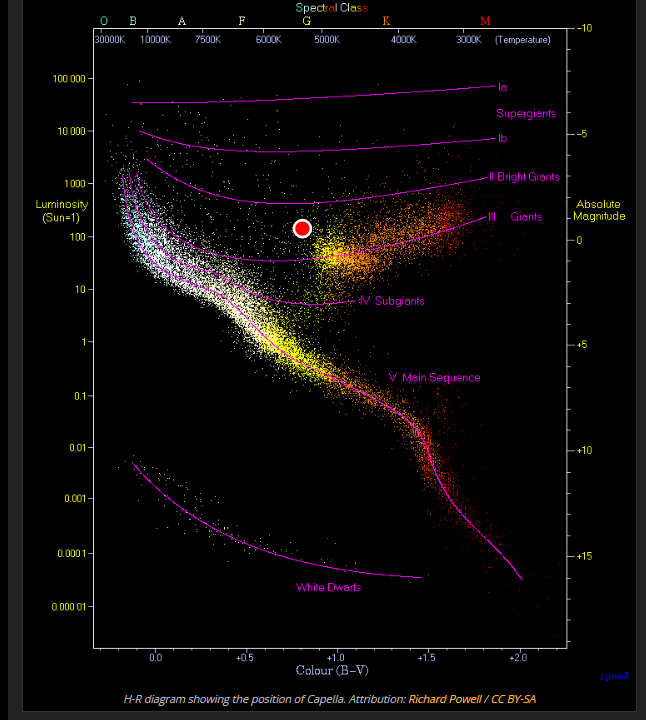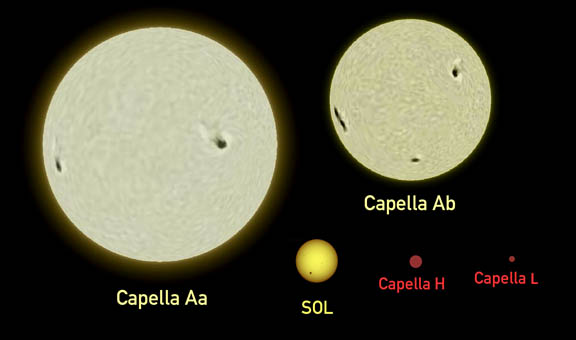Time-lapse video of Capella rising at 11:00 PM EDT through 1:45 AM EDT
Capella is the 3rd brightest star in the Northern Hemisphere. What would happen if we replaced the sun with it?
We explore that question in our full-featured video below. This isn’t just some hypothetical exercise; it helps us better understand how our own solar system will evolve in response to the sun’s evolutionary changes and what that portends for life on our planet.
This is the sixth installment in our ten-part series on the brightest stars and, with it, we’re pleased to present the yellow giant star, Capella, the left elbow of Auriga, the charioteer! α Aurigae, latinised to Alpha Aurigae and abbreviated Alpha Aur or α Aur, Capella is the sixth-brightest star in the night sky, and the third-brightest in the Northern Hemisphere after Arcturus and Vega.
Although it is prominently placed in the northern sky during winter months, Capella is circumpolar for observers north of 44°N latitude. It would, thus set and be below the horizon for more southern latitudes for a brief time during other times of the year.
Its name means “little goat” in Latin, and depicts the goat Amalthea who suckled Zeus in classic Greek mythology.
Capella is relatively close, at 42.9 light-years (13.2 parsecs) from the Sun and is one of the brightest X-ray sources in the sky, thought to come primarily from the corona of Capella Aa.
A Quadruple System
Although it appears to be a single bright star to the naked eye, Capella is actually a quadruple star system consisting of two binary pairs. The first pair, Capella Aa and Capella Ab present as the yellow-white jewel in northern skies. The second binary pair, consisting of Capella H and Capella L, are red dwarf stars visible with a moderate-size amateur telescope (15 – 20 cm diameter).
The twin giant pair is separated from its much fainter companion system by 10,000 Astronomical Units! They, in turn, are separated from each other by 48 AU, a little further than the distance separating Pluto and the sun. It was determined that they are gravitationally bound to Capella A by their distance and proper motion.
Ten thousand AU may seem a large distance to have a gravitational influence when considering the feeble masses of Capella H and L. Not really, when you consider the distance to the Oort Cloud is ~50,000 AU, a body demonstrably linked gravitationally to the sun.
Both binary systems are at the same distance from us of 43 light years and have the same proper motion. Proper motion is the motion of a star or group of stars through the galaxy.
A great lesson in Stellar Luminosity!

The HR Diagram, produced in this case from the Hipparcos mission data, plots stellar luminosity (vertical axis) vs. spectral type and temperature (upper, horizontal axis). Capella is indicated by the large red dot as a yellow-white, G-class giant (Aa and Ab). Attribution: Richard Powell.
This quadruple system makes for a great lesson in stellar luminosity and evolution. One pair has already aged off the main sequence to become twin giants while the other pair remains on the main sequence long after the twin giants are gone.
The primary pair, Capella Aa and Capella Ab, are two bright-yellow giant stars, while their dwarf companions are at the other end of the stellar classification scale. Both are M-class red dwarfs, H more luminous than L with the latter almost at the hydrogen burning mass limit. At magnitude +13.7, the visual limit for a 15 cm (6″) telescope and at 43 light years distant (the same distance as the yellow-giant pair Aa and Ab), it is approximately 10% of the sun’s mass and thus, close to the hydrogen-burning mass limit of 0.072 Solar masses.

Italian amateur astronomer Giorgio Rizzarelli produced this photo of Capella and Capella HL with an 20 cm (8-inch) telescope. Credit: Giorgio Rizzarelli
What would happen to the Solar System if we replaced the sun with Capella?
Let’s find out, but first we need to review the star system and its properties.
Capella A
The first binary pair, Capella Aa and Capella Ab, consist of a K0-III Yellow-orange giant and a G1-III Yellow giant star, respectively. They’re separated by 0.05 arc seconds, the actual resolving power of the Hubble Space Telescope, and are thus characterized as a “spectroscopic” binary. The integrated spectral type is a G3-III Yellow giant.
The combined light of this spectroscopic binary is what we see in the night sky as “Capella” and it is this star that we will use in our hypothetical simulation. Capella Aa is the K0-III giant has 2.6 times the mass of the sun, 8.8 x its radius and 73x its luminosity. Capella Ab, the G1-III giant, is at 2.5 x the mass of the sun,12x its radius and 79 x its luminosity. Since they’re both classified as giants, they’ve evolved off the main sequence and are now burning helium in their cores.
Formation and Planetary System
Based on the similarity of their respective masses and their tight orbit, they most likely formed together. Conversely, it is highly unlikely that they ever had a system of planets. That they are an orbiting binary pair, separated by less than 1 AU (0.74 AU), would have precluded the formation of a stable planetary system.
What’s Next?
They will continue to evolve and expand (reducing their separation and current 104 day orbital period) with the more massive Capella Aa evolving and expanding somewhat more quickly than its slightly less massive companion. As they continue to expand, bringing them ever closer to each other, mass exchange or transfer may occur, further complicating their evolution.
Their estimated age is between 590 and 650 million years and based on their masses, they most likely evolved off the main sequence less than 100 million years ago. Their evolution will now quicken with the current helium burning phase ending soon followed by carbon burning.
Possible Supernova?
A supernova is probably not in their future either. Individually or combined, they lack the minimum 8 solar masses necessary for a Type II, core-collapse supernova. What is possible, however, albeit unlikely, is a situation where either star (most likely, the more massive companion), evolves to become a white dwarf first and then accretes material off the remaining companion. When the white dwarf reaches the Chandrasekhar limit of 1.38 solar masses, a Type Ia supernova could result.
Capella H and L
The second binary pair consists of 2 red dwarf stars, one slightly more massive and luminous than the other. The first, the brightest, Capella H is a M2.5 V main sequence red dwarf star with a mass of 0.35 solar and an apparent visual magnitude of +10.2. The visual threshold for the unaided human eye is magnitude +6.3 under excellent conditions and a clear, dark sky. Its companion, Capella L, is a fainter M4 V star with a mass of 0.1 solar, close to the hydrogen burning mass limit of 0.072 solar. It shines with a visual magnitude of +13.7, the visual limit for a 15 cm (6”) diameter telescope under excellent conditions and a very dark sky.
When analyzed, these 2 stars fit a main sequence linear profile well within one sigma (standard deviation) for mass and luminosity. What does this mean and why does it matter? The following chart plots the Mass-Luminosity Relation for a sampling of red dwarf stars, with Capella H highlighted and falling almost directly on the trend line.

A mass-luminosity chart, produced by the author, highlights Capella L as a textbook example of a low-mass, main sequence red dwarf star.
The Mass-Luminosity Relation
The mass-luminosity relation in astronomy states simply that a main-sequence star’s luminosity varies as some exponent of the star’s mass. For main sequence stars between 0.4 and 2.0 solar masses, that relation would be 4. In other words, a given main sequence star’s luminosity (it’s total radiant-energy output) in that mass range varies as the 4th power of its mass. As an example, the star Sirius A, the brightest star in the sky, is a 2 solar mass, A1 main sequence star with a luminosity of ~25 solar or approximately 24. Between 2.0 and 55 solar mass stars, that value is 3.5. For low-mass stars below 0.4 solar masses, the value is 2.3, a value consistent with the author’s study (note the value of the included trend line).
The mass-luminosity chart, produced by the author, highlights Capella L as a textbook example of a low-mass, main sequence red dwarf star. Why is it less when compared with more massive stars? As discussed in our accompanying video, it is because red dwarf stars are fully convective and are able to use all their hydrogen for energy production.
Red Dwarf Stars
The internal dynamics of Red Dwarfs are not the same as more massive, more luminous stars. In terms of energy production and radiative transfer, the entire star is fully convective, unlike stars such as our sun. What does this mean? The entire star’s mass will be used for energy production. More massive stars such as our sun use only the inner 30% of their radius (the core), containing 70% of the star’s mass, for energy production. This is followed by a “radiative zone” above the core for radiative energy transfer to a convective zone above that to the star’s photosphere. Inside a red dwarf, all the material is available for energy production, hence the term “fully convective”.
It’s important to note that the first binary pair, Capella Aa and Ab, are evolved 2.6 and 2.4 solar mass stars. Based on their respective masses, they were most likely stars similar to or slightly more massive than Vega or Sirius A when they were on the main sequence.
Exploring the Capella Star System, 3rd of the Ten Brightest Stars in the Northern Hemisphere
Related articles
Where are the five brightest stars in our sky?
The Ten Brightest Stars (and where they are, with video) – 1. Arcturus
The Ten Brightest Stars (and where they are, with video) – 2. Vega
The Ten Brightest Stars (and where they are, with video) – 3. Antares
The Ten Brightest Stars (and where they are, with video) – 4. Sirius
The Ten Brightest Stars (and where they are, with video) – 5. Betelgeuse
Sources used in this article
https://theskylive.com/sky/stars/capella-alpha-aurigae-star
https://skyandtelescope.org/observing/tale-of-capella-and-the-two-red-dwarfs1209150912/
https://science.nasa.gov/solar-system/oort-cloud/




